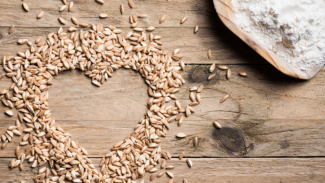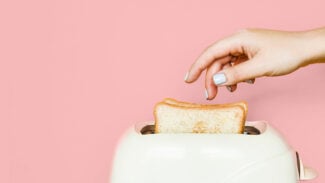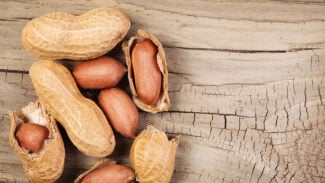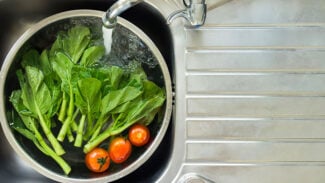Hiya Gorgeous,
You might have read my other blog on gluten (4 Gluten Sensitivity Symptoms to Watch Out For), which covers the conditions that make gluten a no-no, signs you may be sensitive to it, how to determine if it’s causing you issues and whether it’s an absolute must to skip this grain-based protein if you tolerate it well (good news: it isn’t!). Today, I want to expand upon the gluten conversation and discuss how to eat gluten-free and maintain a healthy diet.
While it’s not always necessary to avoid it if it works for you, it seems every day there’s a new story about someone who felt a lot better when they ditched gluten from their plate. Maybe you’re one of them, or maybe you’re interested in finding out if a gluten-free lifestyle can help you feel more fabulous. Either way, know this: A gluten-free diet isn’t necessarily a healthy diet (but it can be and I’ll show you how).
To begin, let’s look at the pros and cons of going gluten-free, and the three steps you can take to reduce or eliminate your intake. Plus, I’ve also mapped out a one-day gluten-free meal plan for ya! Check it all out below…
The Pros of Gluten-Free
Well first of all, if you have celiac disease, whether to avoid gluten isn’t even a question—you MUST follow a gluten-free diet, and you probably need to check your toothpaste, laundry detergent, deodorant and play-doh for gluten as well.
But for those of you who just want to feel more vibrant, reducing the gluten in your diet can mean:
- Eating more whole foods. With gluten-packed pasta, crescent rolls and biscuits off the menu, chances are you’ll be reaching for more sweet potatoes, quinoa, beans, lentils, millet, brown rice and other gluten-free grains—wonderful alternatives. These options are more nutrient-rich and are much better fuels for your tank than refined grain products.
- Eating fewer sugary sweets. Cakes, cookies, brownies, pies… More often than not, these sweet treats are made with wheat products, and wheat contains gluten (boooo!). Saying buh-bye to gluten may mean you’re no longer dipping into the cookie jar, instead curbing your sugar cravings with healthier swaps like fruit or dark chocolate. These choices have vitamins and minerals to accompany their satisfying sweetness—bonus!
- Improving thyroid function. Celiac or not, ditching gluten may help improve thyroid function if you have an autoimmune thyroid condition such as Hashimoto’s or Graves’ disease (reference).
The Cons of Gluten-Free
At this point you may be thinking, Well this all sounds great, Kris, count me in. Gluten-free diet, here I come! Not so fast, toots. If you’re not cautious, following a gluten-free path can steer you in the wrong direction. Here are some pitfalls to watch out for:
- Getting tricked by labels. Again, “gluten-free” doesn’t necessarily mean “healthy.” Breads and baked goods marked gluten-free are frequently made of rice, potatoes and corn, and are often much lower in fiber than their gluten-containing counterparts (wheat bran is a great source of insoluble fiber). And then there are the “naturally gluten-free” items that marketers position as better-for-you choices based solely on the absence of the demonized ingredient of the moment. A bunch of Halloween candies are gluten-free and are now labeled that way. Sugar, nougat, caramel, syrups, hydrogenated oils—all zero gluten. See how a gluten-free diet can easily become unhealthy if you’re not careful?
- Seeing your grocery bill skyrocket. Until demand increases considerably, gluten-free goods are going to be pricey—sometimes more than three times the cost of the regular versions (think store-bought waffles, breads, muffins, etc.). Whenever possible, make gluten-free foods from scratch to avoid the hefty hike in grocery budget (tips and ideas below).
- Missing out on iron and B vitamins. Wheat flour is fortified with iron and B vitamins, which may be the richest source of these nutrients in a person’s diet if he or she isn’t getting in enough nutrient-rich whole foods. If wheat flour is your main source of iron and B vitamins and you decide to switch to gluten-free breads and flours, make sure they’re fortified or that you’re taking a B-complex vitamin and/or multivitamin.
- Taking in too many calories. Lots of folks shun gluten thinking it will help them lose weight, but if you’re merely replacing your typical gluten staples with gluten-free breads, muffins and other gluten-free starches, you may be doing more harm than good. Several gluten-free products rely on oils, eggs and low-fiber starches to mimic wheat flour and gluten. Extra oil means extra calories, and a lack of fiber makes these foods easier to overeat—double whammy.
- Finding egg whites everywhere. Egg whites help give gluten-free breads and baked goods the binding and bounce that gluten usually supplies. If you already avoid eggs and want to avoid gluten, too, it can be tough to find products in the grocery store that meet your criteria. You’ll likely be making lots of homemade goodies with flaxseed meal and chia seeds.
3 Steps to Go Gluten-Free the Healthy Way
Follow these three tips to scale back or eliminate gluten without the negatives:
- 1. Enjoy high-fiber, gluten-free whole grains in place of wheat, barley and rye. Try naturally high-fiber quinoa, amaranth, millet, buckwheat groats, gluten-free oats, sorghum flour and popcorn over white rice, rice flour, potatoes and corn. Choose products that have at least four grams of fiber per serving. Here’s a good resource for more info on high-fiber, gluten-free grains.
2. Bake from scratch. Lots of gluten-free baked goods are not only expensive, but they rely heavily on preservatives and eggs to mimic the “glueyness” of gluten. Check out sites like Oh She Glows and Minimalist Baker for some tasty inspiration.
3. Get creative with legumes. Beans and lentils are loaded with nutrition and are a perfectly starchy substitute for gluten-containing flours and foods. Use them in place of pasta, or try bean-powered pasta products like the yummy options from Banza. You can even use beans to make baked goods!
Psst… You’ll also find some epically delicious, naturally gluten-free recipes in my tasty plant-based cookbook, Crazy Sexy Kitchen. A few of them are in the downloadable goodie below. So much yum!
1-Day Gluten-Free Meal Plan + Shopping List

There are so many incredible gluten-free recipes available today as folks start to experiment with cutting gluten and getting creative in the kitchen. I’ve put together this one-day sample meal plan—including the full shopping list—of some of my fave gluten-free meals and snacks. Enjoy!









Everyone talks about Gluten Free as a trend but I have Celiac Disease. Those of us with Celiac disease have no choice but to ban gluten from our food. I wish more of this was discussed because there probably a lot of people with this disease that has been undiagnosed.
I hear you Jill! I went undiagnosed until 30! I am so grateful because then I spotted it in my daughter right away…
I had Hashimotis thyroid issues, but when I cut out all Gluten and caffeine. My issues completely went away!!! My TSH levels are all normal and I didn’t have to go on any medication!!!
I already knew so but your story gives me hope 🙂 (I have Hashimoto’s as well)
Thank you Lynn!
I left a reply earlier but think it didn’t go through! I love this post Kris…thank you for pointing out that gluten free does not necessarily mean healthy. I have been gluten free for years and feel amazing, but I bypass all of the processed gluten free junk. Love your blog and all you do!
So happy it resonated, Elizabeth. xo!
Hi there. Had TT June ’14 cancerous. Many in same situation rave bout gluten free helping them but I’ve found not hugely beneficial to me when I switched over to gf.
I have however struggled with weight gain. Still trying make this right Plan for myself.
People can feel better removing gluten from their diet because it lowers the FODMAPS in their diet rather than the gluten itself being an issue
Yep, FODMAPS can be the main issue for some. Thanks, Natalie!
Hi There,
Teff is another gluten free grain. 100 grams has 42% iron and 25% B6 (daily value).
I hope this help.
Cheers,
In reference to thyroid function you going gluten free can help specifically if you have *automimmune* thyroid dysfunction. Do you mean to say *only* if you have autoimmune thyroid dysfunction? I have thyroid disease, it’s hereditary, but it’s not autoimmune, not hashimoto’s or Grave’s.
I have the same question re not autoimmune thyroid issues and eliminating gluten.
I got some further deets from our Crazy Sexy RD, Jennifer Reilly on this. Here’ what she had to say; hope it’s helpful!: “Research is quite strong that a gluten-free diet can help autoimmune thyroid disease mainly b/c eating gluten may cause your body to attack your thyroid gland (a case of mistaken identity). So, avoiding gluten when an autoimmune thyroid disease is present can help tremendously when it comes to managing thyroid hormones and function (regardless of whether or not gliadin sensitivity is present). Research is not as definitive when it comes to other thyroid disorders. However, many people with a non-autoimmune hyper- or hypothyroid disorder have reported feeling more energized and better management of thyroid hormones when following a gluten-free diet. So, it may be worth a try for you. I’d give it a good 2 to 3 weeks of gluten-free before deciding if it has helped or not. It certainly can’t hurt especially if you follow these healthy gluten-free tips. :)”
I love you Kris Carr. I hope to meet you one day and give you a huge hug. I hope you don’t mind, but I do have one little thing I’d like to add for your readers (that is if anyone even bothers to read my comment!). There is another reason that is being overlooked as to why we should avoid gluten no matter if we have a sensitivity or celiac disease. It’s the pesticides/glyphosate. The majority of wheat crops are smothered with Monsanto’s Ready Roundup. This is causing so many serious health problems including cancer. The WHO just named it as a probable carcinogen . This article was written before the WHO just came into the picture, but it explains a lot. http://www.thehealthyhomeeconomist.com/real-reason-for-toxic-wheat-its-not-gluten/ I hope it’s helpful for those who are interested.
Thanks for adding that important info, Mary. Glyphosate use is a real problem that everyone should be aware of!
Hi Kris I am a vegetarian and a runner and now I can’t eat any gluten or I bloat and look like I am 6 months pregnant ugh! I am always looking for new and easy receipes because it’s hard for me to eat I really need to read the ingredients because it may say it is a rice cake but has corn flour in it . Thank you for the advice I look forward to reading your one day meal plan
Jennifer
Hi Jennifer,
since you are a runner, you would benefit from smoothies made with GF protein powders and packed with fruits and vegetables. They are nutrient dense, easy to make, transport and drink and will not fill you up while giving your body what it needs. There’s such an array of GF protein powder supplements on the market now, unflavored or not to choose from. Kris’s books have numerous smoothie recipes for variety.
Thanks so much Janeen!
I’ve been wanting to try gluten free as my thyroid is out of whack and I feel terrible. How hard is it to eat gluten free and vegan? It seems so limiting, especially when eating out. I’m sure the benefits far outweigh those concerns though!
Hi Stacey, It can be a little tricky doing vegan and gluten-free, but not impossible at all. Lots of people do it! When eating out, you can still rely on tofu, tempeh (as long as it isn’t with gluten-containing grains like barley), beans, nuts, seeds, rice, quinoa and potatoes. Things you may have eaten out before like pasta, whole grain bread, and seitan would be off your menu, but call restaurants ahead of time if it looks like they aren’t offering anything tasty that is also gluten-free and vegan. Restaurants can almost always make a mean plate of roasted veggies, beans and rice, or tofu, broccoli and roasted potatoes. Since you don’t have celiac, you probably don’t have to be as strict when eating out about your foods touching other gluten-containing foods (for example, French fries cooked in a fryer with breaded foods). Aside from eating out, vegan, gluten-free sandwich bread is a little hard to find, so I’d suggest mastering your own batch and freezing individual slices. Hope that helps!
Eating out can be a challenge, but I have found a few go to places that I can suggest when friends and family want to eat out. It never hurts to ask if they have a gluten free menu, you’d be surprised how many places do now. I also find it helpful to check allergen information on a restaurant’s website. A lot of the restaurants have this information available online, so you can easily see what contains eggs, dairy and wheat. I always check these before going anywhere, as I also have a terrible reaction to soy protein. Some places will be terribly limiting, but you’d be surprised by others. I just had a very tasty meal at a barbecue joint of all places, for a friend’s birthday.
Hi Stacey, check out the FB group Gluten-Free Vegans – always lots of good support there.
Thanks for shining the light on going Gluten-free. I’ve been off the gluten for over 6 years and feel great! You are correct in saying it helps you eat more whole grains, and fiber. I lost a lot of weight just from cutting out gluten and sugar and the best part is the mental clarity I have since going gluten and sugar free. I was in a mental fog most of the time and didn’t even realize it!
Love all you do and am enjoying your Crazy Sexy Juice Book and your great guidance to Go Green!!
Here’s to our Health!
Cheers to your success, Maiya! xo
Thank you! Your awesome, I am gluten allergic and Crazy C Disease! Nice to see your take on it, and thanks for the recipe. I LOVE YOU, your articles, what you give back……I have been following you for a while now!!!! You ROCK SISTER!
My Paleo friend helped me realize in May of this year that my constant headaches (some migraines) were caused by wheat so I changed my diet to see. She was right. Since May, I’ve lost 28 pounds and don’t crave junk food. I feel better, too. I upped my meats, fruits, veggies, and yogurt and drink lemon water 24/7. The headaches come about once a month now (or less) and that’s when I mistakenly eat something with gluten. Sometimes, they’re so bad, that I throw up…several times. It’s a process but I’m learning what my body can tolerate and what it can’t. I’ve also learned that no medicine, no essential oil, not even an Epsom salt bath will cure a gluten headache. They always last 2-3 days and will not go away until the gluten leaves my system.
Yes I have celiac and gluten free for four years now I still get sick have a problem eating out or going to someone home. I carry a cooler all the time. So I can be prepared to eat because people really don’t understand that you can get contamunated quickly and believe you can end up in the hospital it is a terrible diease and no meds or cure. You live each day and hope that the next day will be good also. i bought two of your books last week and I am juicing and reading thank you so very much.
Hi Kris, I am embarking on gluten free, but am really worried about weight loss – I really don’t want to lose weight, but I can’t see how to keep it on if I’m not eating bread and biscuits! Can you advise?
When I went gluten free, I lost weight the first year, until I got used to it, but after that, I gained it back and then some. After being gluten free for 4 years, I returned to wheat, and I have lost back down to my normal weight. I never needed to lose weight, so that might be a factor. If being gluten free helps people eat healthier foods, perhaps they will lose weight permanently, but I have watched friends cut food groups again and again. At first they always lose weight, but after a year, and they’ve made new food friends, they have most always gained the weight back. So I’d say don’t worry. In time it will work out. Of course I am no expert. My expert said to add in healthy fats like avocados.
Hi! I see you “recommend ” cashewnuts. Do you consider it as a nut? People say, and Ive seen its so much bad things around harvesting the cashews an what about the nutrition side? Its awfully popular and easy to use, but People working with harvesting them, hurts their fingers, because of some oil in the fruit around? Peanuts are nutritious too, but should be avoided while losing weight? I mean of course the ones With Shells around. Which plantfamily are cashews and peanuts in? Why do many People get allergetic towards them? Hard to Digest?
I have been gluten free for years and have never once bought a gluten free product like bread, muffins, cereal, etc. By loading up on fresh veggies and some fruit, as well as some ethically sourced animal protein (but no dairy) I feel great. Sweet potatoes are one of my favorite carbs, and I do a little rice now and then. Last night I had a chocolate craving and made amazing black bean brownies. No gluten there but delicious. I don’t think everyone needs to go gluten free, but everyone would feel better cutting out the processed white stuff. Thanks for all you do Kris!!!
I was actually the opposite. I went gluten free for 4 years and was very strict. I did so on a doctor’s suggestion b/c of a thyroid disease. The disease did go into remission, but I felt worse, and my hair looked terrible, and my digestion was so slow. Then, while gluten free I got a new autoimmune disease, and so I said forget it. If being gluten free did not help keep me from getting another autoimmune disease I am done. I went back to gluten, and the thyroid disease hasn’t returned. I feel much better. My digestion is normal, and my hair is thick again. Taking out gluten is not for everyone–especially if you are already eating a healthy diet. Anyway–just my experience. Of course if you are gluten sensitive, stay away. But for some of us, we are actually less healthy eliminating gluten. It’s SUCH a relief now b/c I don’t have to think about food all the time. Thinking about food all the time is so exhausting. What a relief!
Have tried Explore Asian noodles – they are really good and are a big notch above some of the pasta products out there. Glad you mentioned the dearth of over processed “gluten free” products out there. It reminds me of the “fat free” food craze of the 90’s- the products were usually loaded with sugar and most people gained weight. I am blessed not to have any food sensitivities, unless I digress & eat processed food. Yuk- never a good idea anyway.
Avoiding gluten is something I’m really seriously considering. I have thyroid cancer and I’ve heard that it can help with the fatigue, fuzzy head etc. I’m slowly trying to transition away from gluten but I’m finding it such a challenge! I do love the Oh She Glows cookbook and the Fork & Beans site – two of my favorites. Thanks for the helpful tips.